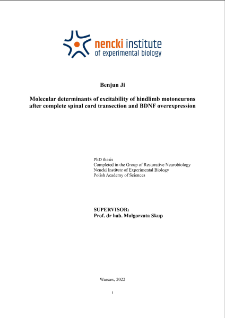- Search in all Repository
- Literature and maps
- Archeology
- Mills database
- Natural sciences
Advanced search
Advanced search
Advanced search
Advanced search
Advanced search

Object
Title: Molecular determinants of excitability of hindlimb motoneurons after complete spinal cord transection and BDNF overexpression : PhD thesis
Institutional creator:
Instytut Biologii Doświadczalnej im. Marcelego Nenckiego PAN
Contributor:
Skup, Małgorzata (1954- ) : Supervisor
Publisher:
Nencki Institute of Experimental Biology PAS
Place of publishing:
Description:
134 pages : illustrations ; 30 cm ; Bibliography ; Summary in Polish
Degree name:
Degree discipline :
Degree grantor:
Nencki Institute of Experimental Biology PAS ; degree obtained: 12.10.2022
Type of object:
Abstract:
Studies using spinal cord injury (SCI) models investigated molecular changes in neurotransmission-related molecules in motoneurons (MNs) mostly at the late postlesion phase, when hyperexcitability considered to be the reason of muscle spasticity is well established. However, in experimental SCI in rodents the onset of spasticity is seen as early as one week postinjury. Patterns and relations of expression level of genes coding for membrane proteins instrumental for excitatory vs inhibitory neurotransmission in the subacute phase of SCI when excitability starts to restore, are not clear.The aim of my work was to clarify the direction and extent of transcriptional regulation of receptors mediating excitatory and inhibitory neurotransmission and of functionally associated channels in hindlimb MNs of adult rats, at the second week postinjury. I hypothesized that fast molecular changes in lumbar MNs develop in response to the loss of inputs. These responses may disturb the balance of excitatory and inhibitory receptors and related ion channels in MNs. Because after SCI the extent of impairment of inputs to MNs innervating extensor and flexor muscles operating at the ankle joint is different, I examined separately MN pools innervating ankle extensor (Gastrocnemius lateralis; GL) and flexor (Tibialis anterior; TA) muscles.A promising way to treat SCI is by spinal cord enrichment with brain derived neurotrophic factor (BDNF). Previous studies showed that BDNF overexpression induced with AAV-BDNF injection caudal to the lesion site improves locomotor abilities and upregulates transcript levels of glutamatergic and GABAergic markers in the interneurons, presynaptic to MNs. While the study showed beneficial role of BDNF in adapting the network to increased activity, undesirable behavioral effects suggesting overexcitability were observed in time, which set my second aim: to characterize the effect of spinal AAV-BDNF administration on gene expression studied in the first part of my project, and identify target molecules of pro-excitogenic potential.Prior to complete spinal cord transection (SCT) at the thoracic Th11 level, retrograde tracers were injected to the respective muscles to identify MNs. After SCT, PBS or AAV-BDNF was injected bilaterally to the lumbar L1/2 segment. Non-lesioned rats with injected tracers served as controls. At two weeks postlesion, locomotor performance of spinal rats was evaluated on a running treadmill. After animal perfusion, GL and TA MNs were isolated from longitudinal spinal sections by laser-assisted microdissection, mRNA was isolated and reverse- transcribed into cDNA. Transcript levels of selected neurotransmitter receptors, ion channels and Cl- transporters were assayed using quantitative PCR.
Detailed Resource Type:
Resource Identifier:
Source:
Language:
Language of abstract:
Rights:
Terms of use:
Copyright-protected material. May be used within the limits of statutory user freedoms
Copyright holder:
Publication made available with the written permission of the author
Digitizing institution:
Nencki Institute of Experimental Biology of the Polish Academy of Sciences
Original in:
Library of the Nencki Institute of Experimental Biology PAS
Access:
Object collections:
- Digital Repository of Scientific Institutes > Partners' collections > Nencki Institute of Experimental Biology PAS
- Digital Repository of Scientific Institutes > Partners' collections > Nencki Institute of Experimental Biology PAS > Dissertations
- Digital Repository of Scientific Institutes > Partners' collections > Nencki Institute of Experimental Biology PAS > Dissertations > PhD Thesis
- Digital Repository of Scientific Institutes > Literature > Thesis
Last modified:
Dec 16, 2024
In our library since:
Oct 10, 2022
Number of object content downloads / hits:
129
All available object's versions:
https://rcin.org.pl./publication/272893

 INSTYTUT ARCHEOLOGII I ETNOLOGII POLSKIEJ AKADEMII NAUK
INSTYTUT ARCHEOLOGII I ETNOLOGII POLSKIEJ AKADEMII NAUK
 INSTYTUT BADAŃ LITERACKICH POLSKIEJ AKADEMII NAUK
INSTYTUT BADAŃ LITERACKICH POLSKIEJ AKADEMII NAUK
 INSTYTUT BADAWCZY LEŚNICTWA
INSTYTUT BADAWCZY LEŚNICTWA
 INSTYTUT BIOLOGII DOŚWIADCZALNEJ IM. MARCELEGO NENCKIEGO POLSKIEJ AKADEMII NAUK
INSTYTUT BIOLOGII DOŚWIADCZALNEJ IM. MARCELEGO NENCKIEGO POLSKIEJ AKADEMII NAUK
 INSTYTUT BIOLOGII SSAKÓW POLSKIEJ AKADEMII NAUK
INSTYTUT BIOLOGII SSAKÓW POLSKIEJ AKADEMII NAUK
 INSTYTUT CHEMII FIZYCZNEJ PAN
INSTYTUT CHEMII FIZYCZNEJ PAN
 INSTYTUT CHEMII ORGANICZNEJ PAN
INSTYTUT CHEMII ORGANICZNEJ PAN
 INSTYTUT FILOZOFII I SOCJOLOGII PAN
INSTYTUT FILOZOFII I SOCJOLOGII PAN
 INSTYTUT GEOGRAFII I PRZESTRZENNEGO ZAGOSPODAROWANIA PAN
INSTYTUT GEOGRAFII I PRZESTRZENNEGO ZAGOSPODAROWANIA PAN
 INSTYTUT HISTORII im. TADEUSZA MANTEUFFLA POLSKIEJ AKADEMII NAUK
INSTYTUT HISTORII im. TADEUSZA MANTEUFFLA POLSKIEJ AKADEMII NAUK
 INSTYTUT JĘZYKA POLSKIEGO POLSKIEJ AKADEMII NAUK
INSTYTUT JĘZYKA POLSKIEGO POLSKIEJ AKADEMII NAUK
 INSTYTUT MATEMATYCZNY PAN
INSTYTUT MATEMATYCZNY PAN
 INSTYTUT MEDYCYNY DOŚWIADCZALNEJ I KLINICZNEJ IM.MIROSŁAWA MOSSAKOWSKIEGO POLSKIEJ AKADEMII NAUK
INSTYTUT MEDYCYNY DOŚWIADCZALNEJ I KLINICZNEJ IM.MIROSŁAWA MOSSAKOWSKIEGO POLSKIEJ AKADEMII NAUK
 INSTYTUT PODSTAWOWYCH PROBLEMÓW TECHNIKI PAN
INSTYTUT PODSTAWOWYCH PROBLEMÓW TECHNIKI PAN
 INSTYTUT SLAWISTYKI PAN
INSTYTUT SLAWISTYKI PAN
 SIEĆ BADAWCZA ŁUKASIEWICZ - INSTYTUT TECHNOLOGII MATERIAŁÓW ELEKTRONICZNYCH
SIEĆ BADAWCZA ŁUKASIEWICZ - INSTYTUT TECHNOLOGII MATERIAŁÓW ELEKTRONICZNYCH
 MUZEUM I INSTYTUT ZOOLOGII POLSKIEJ AKADEMII NAUK
MUZEUM I INSTYTUT ZOOLOGII POLSKIEJ AKADEMII NAUK
 INSTYTUT BADAŃ SYSTEMOWYCH PAN
INSTYTUT BADAŃ SYSTEMOWYCH PAN
 INSTYTUT BOTANIKI IM. WŁADYSŁAWA SZAFERA POLSKIEJ AKADEMII NAUK
INSTYTUT BOTANIKI IM. WŁADYSŁAWA SZAFERA POLSKIEJ AKADEMII NAUK


































